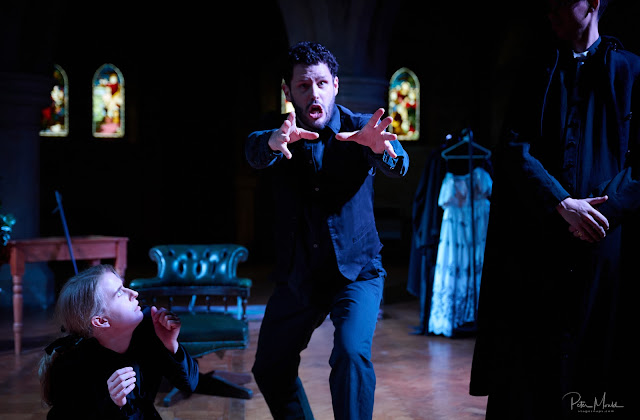 |
| Mozart: Le nozze di Figaro – Rosemary Carlton-Willis, Marcio da Silva, Joshua Furtado-Mendes – Ensemble OrQesta at Arcola Theatre’s Grimeborn Fesitval |
Mozart: Le nozze di Figaro; Marcio da Silva, Helen May, Oshri Segev, Hollie-Anne Clark, Rosemary Carlton-Willis, Anna-Luisa Wagner, director: Marcio da Silva, Hastings Philharmonic Orchestra Ensemble, conductor: Kieran Staub; Ensemble OrQuesta Company at Arcola Theatre’s Grimeborn Festival
Reviewed 31 August 2024
Comedy and physical theatre along with veins of seriousness and anger in a chamber production that really drew you into Mozart and Da Ponte’s world
And interesting influence on Mozart and Da Ponte’s operas is the sequence of operas created by Galuppi and Goldoni in Venice in the mid-18th century which mixed serious aristocrats with comic servants running rings around them. In Galuppi’s operas the count is usually a castrato, but if you transfer him to a baritone, you have the situation in Mozart’s Le nozze di Figaro. Here the mix of characters, seria, buffa and semi-seria recalls Mozart’s letter about this mix of character types in Don Giovanni. The challenge with any production of Le nozze di Figaro is to get this balance of the serious and the comic.
At Arcola Theatre‘s Grimeborn Festival, Marcio da Silva‘s Ensemble OrQuesta returned for the company’s sixth visit to the festival, this time moving from the Baroque to the Classical with Mozart’s Le nozze di Figaro (seen 31 August 2024). Marcio da Silva directed (and played Figaro) with Kieran Staub conducting a septet drawn from the Hastings Philharmonic Orchestra (of which da Silva is founder and artistic director), Izabela Stocka and Andrew Kelly, violins, Jordi Morell, viola, Natalie Hancock, cello, Adam Churchyard, double bass, Boyan Ivanov and Fresca David, clarinets.
Marcia da Silva was Figaro, Helen May was Susanna, Oshri Segev was the Count, Hollie-Anne Clark was the Countess, Rosemary Carlton-Willis was Marcellina, Anna-Luise Wagner was Cherubino, Flavio Lauria was Don Bartolo, Tara Venkatesan was Barbarina, Joshua Furtado-Mendes was Basilio and Don Curzio, and Jay Rockwell as Antonio.
During the overture, the singers acted out the plot so far, from Marcellina and Bartolo conceiving Figaro right through to Figaro meeting Susanna, an amusing conceit but helpful too.
With the audience on three sides of the acting area, this was an up close and personal performance, concentrating on the performers rather than the setting. A couple of chairs and a table were put to excellent use here, along with a screen. For the first two acts, everyone was in black (or dark gray), yet with clothes reflecting their role in the class hierarchy. Dress became more period in the second half, and great thought and imagination had gone into the exchange between the Countess and Susanna.
This was a very physical, very active production, at times veering into physical theatre. Moments like the end of Act One, with the ludicrous comedy around hiding in the chair, was mined for its utmost physical comedy. Similarly the end of Act Two was simple and effective, yet also with a vein of comedy, whilst the sextet in Act Three turned active indeed. Yet the physicality often aided the dramaturgy, and the comedy was only one element. It worked because there were other layers, so that Ostri Segev’s Count was a nasty piece of goods who took himself seriously indeed, so he was positively disturbing. Whereas Hollie-Anne Clark’s Countess had the sort of poise that meant she seemed to float through life with it barely touching her.
As Figaro, Marcio da Silva was darker and angrier than some, his Act One aria about giving the Count his comeuppance was positively disturbing. There was never any doubt of his love for Helen May’s sparky Susanna, but this Figaro was so quick to flare-up you suspected that the liaison would be tempestuous. His relationship with his parents, Marcellina and Bartolo, after the revelations in Ac Three was by no means as easy and warm as we might have expected. As Susanna, Helen May was no simpering soubrette and there was an edge to her performance too. She was more than capable of being managing, and quite serious in her approach. But in the great moments such as Act Four’s ‘Deh vieni’, May was well worth listening too, and suggested a possible Countess.
As I have said, Ostri Segev was a demanding and at times unpleasant Count, yet he never descended into common violence, he was aristocratic. Segev’s voice had a dryness to the tone which emphasised the character and remove something of the warmth. Hollie-Anne Clark was a poised and elegant Countess, Quite light of voice, she brought great style to her performance and a nice element of melancholy. Both her arias were finely touching, yet May and Anna-Luise Wagner’s Cherubino made the utmost of their attraction. And after all, in Beaumarchais’ third play in the trilogy (Le nozze di Figaro is based on the second play), the Countess has had a child by Cherubino, so this vein is an important. Clark’s Countess was all elegant poise in her touching forgiveness of the Count at the end of Act Four, but as the production faded to black, our last image was of the Countess and Cherubino in a clinch.
Anna-Luise Wagner was an engaging young man, this Cherubino had a winning smile, a way with anything in a skirt and a sense of permanently raging hormones. It was a nice device to have his Act Two aria, sung to the Countess and Susanna in a deliberately sub-par manner as if he was nervous. This Cherubino did have touching moments, but he was undoubtedly funny.
Rosemary Carlton-Willis and Flavio Lauria were pure comic delight as Marcellina and Don Bartolo. She not so much the vicious old maid, but he very much a curmudgeon. Carlton-Willis got to sing Marcellina’s Act Four aria where the anger against men made a great deal of sense in the context of the vein of anger running through the production. Joshua Furtado-Menses sang Basilio and Don Curzio, eliding the two with much physical comedy. Tara Venkatesan made a charming Barbarina with a lovely account of the Act Four aria, whilst Jay Rockwell provided fine (and not too drunken) support as Antonio. There was no chorus, the ensemble was niftily drawn into supplying this.
Kieran Stabu doubled as conductor and piano continuo. The recitatives rattled along at a wonderful rate of knots, nothing stately here, so much so that the surtitles often couldn’t keep up. Yet the result was a vivid sense of comic drama rather than breathlessness.
The instrumental ensemble played an orchestration by Marco da Silva that was effective, though I would have liked more woodwind in the mix, and having a double bass and cello seemed to make the arias somewhat bass heavy.
The production was engaging in the way it drew you in and carried you along. These characters were just in front of your nose and made you part of their concerns. Yet, for all the production’s comedy and physical theatre, there was a vein of seriousness and anger as well, a reflection of both the complexity of Mozart and da Ponte’s opera and Beaumarchais’ original play.
The blog is free, but I’d be delighted if you were to show your appreciation by buying me a coffee.
Elsewhere on this blog
- To Lviv with Love: Paul Mann combines conducting in the Ukraine with investigating neglected composers for Toccata Classics, including the Swiss composer Richard Flury – interview
- Prom 52: Intelligent, vivid & satisfying account of Bizet’s Carmen from Rihab Chaied, Evan LeRoy Johnson, Anja Bihlmaier at Glyndebourne’s visit to the BBC Proms – opera review
- Prom 50: Two rarities and a classic from Jakub Hrůša and Czech Philharmonic – concert review
- Prom 49: A consumate & deeply felt account of Suk’s Asrael Symphony crowns the Czech Philharmonic’s first Prom appearance – concert review
- Far from special interest: discs of brass band music by Arthur Bliss and Malcolm Arnold, two brilliant and highly satisfying portraits – record review
- Into the unknown: soprano Aoife Miskelly makes her debut with Vache Baroque in Pergolesi’s rarely performed opera, L’Olimpiade – interview
- Responses to Thomas Hardy: composer
Arthur Keegan’s complex web of music new and old, atmospherically
performed by Lotte Betts-Dean, James Girling & Ligeti Quartet – record review - Prom 40: Transcending limitations, Bach’s St John Passion from Masaaki Suzuki and Bach Collegium Japan – concert review
- Prom 37: intense contrasts thundering cannonades to personal intimacy, Antonio Pappano conducts Britten’s War Requiem – concert review
- Music is the best argument for its continued existence: John Largess of one of the USA’s most celebrated quartets, the Miró Quartet – interview
- More Buffy the Vampire Slayer than German Romanticism: Gothic Opera’s Der Vampyr at the Grimeborn Festival – opera review
- Substantial and satisfying listening: Stuart Hancock’s score for the new film, Kensuke’s Kingdom – record review
- White-hot dramatic impetus: Meyerbeer’s Le prophète on LSO Live uses a traditional version but captures the work’s essential drama – record review
- Home







